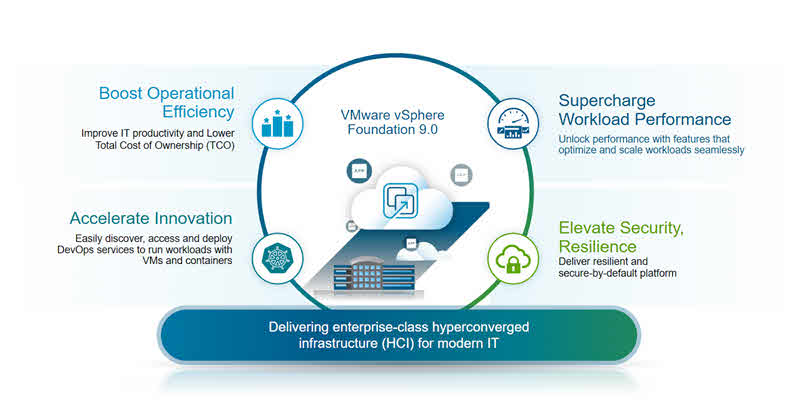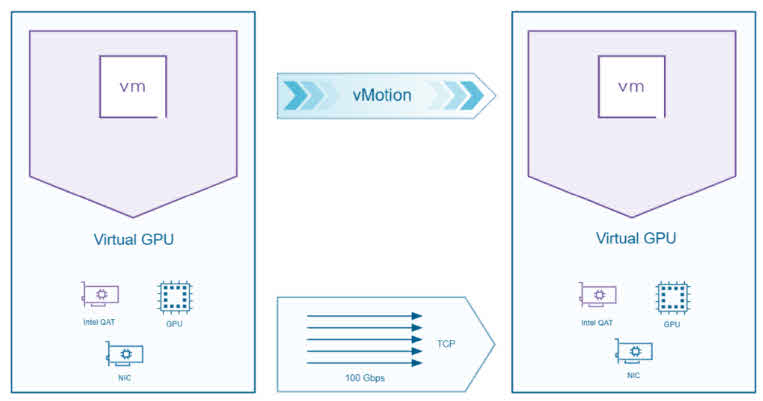VMware vSphere has long been the foundation of enterprise virtualization. Now, with VMware vSphere 9.0, VMware is taking another leap forward to support modern workloads like AI/ML, GPU-intensive applications, hybrid cloud, and containerized environments.
In this comprehensive guide, you’ll learn:
- What’s new in VMware vSphere 9.0
- Major feature enhancements and architectural changes
- Licensing changes and the move to subscription
- How vSphere 9 compares to vSphere 8 and 7
- The differences between VMware Cloud Foundation (VCF) 9 and VMware Virtual Foundation (VVF) 9
- Supported and unsupported hardware from major vendors
- Real-world migration scenarios
- Troubleshooting FAQ
- Best practices for upgrading
This post is my first one after a few very difficult months, following the loss of my father. I hope I can get back on track and continue the path I was on. Let’s dive in.

Introduction to VMware vSphere 9.0
VMware vSphere 9.0 is the latest release of VMware’s industry-leading virtualization platform. It delivers improved performance, stronger security, and better management for both traditional VMs and next-gen workloads like containers and AI/ML models.
The vSphere 9 release continues VMware’s push to make your on-premises infrastructure more cloud-smart, integrated, and resilient.
Major New Features in vSphere 9.0
Scalability Improvements
- VM Size Limits: Now up to 1,024 vCPUs and 24 TB RAM per VM on supported hardware.
- Clusters: Scale up to 128 hosts per cluster, supporting approximately 12,000 VMs.
- AI-driven DRS 2.0: Dynamic resource balancing powered by AI algorithms for improved performance and power efficiency.
Security Enhancements
- Native Key Provider Plus: Now FIPS 140-3 compliant for improved encryption.
- Confidential Computing: Supports AMD SEV-SNP and Intel TDX for stronger workload isolation.
- Immutable Snapshots: Protect against ransomware with tamper-proof VM snapshots.
- Policy-based Compliance: Built-in compliance templates for PCI-DSS, HIPAA, GDPR, and more.
AI & GPU Optimizations
- vGPU Multi-Tenancy: Improved resource sharing for NVIDIA and AMD GPUs.
- AI/ML Zones: Designate specific zones within clusters for AI workloads.
- Tanzu AI Toolkit: Integrate Kubernetes-based AI pipelines seamlessly.
Lifecycle & Management
- Lifecycle Manager 2.0: Unified ESXi and firmware updates.
- Rolling vCenter Upgrades: Reduce downtime during upgrades.
- Enhanced HTML5 UI: Faster, mobile-friendly admin interface.

Licensing Changes in VMware vSphere 9
VMware vSphere is available in two standalone editions, VMware vSphere Standard and VMware vSphere Enterprise Plus, and is also included as a component in VMware Cloud Foundation and VMware vSphere Foundation. Note that vSphere Standard and vSphere Enterprise Plus are only available as versions up to the 8 Update 3 release. Currently, vSphere 9.0 features are only available as part of VMware vSphere Foundation 9.0 and VMware Cloud Foundation 9.0.
You can find more information on this document: vmw-datasheet-vsphere-product-line-comparison
Comparing VMware vSphere 9 to Previous Versions
Same as previous releases, VMware vSphere 9.0 can provide more capacity and hosting larger workload compared to earlier versions, let’s review some changes in features and capabilities:
| Feature | vSphere 7 | vSphere 8 | vSphere 9 |
|---|---|---|---|
| Max VM vCPUs | 768 | 896 | 1,024 |
| Max VM RAM | 12 TB | 16 TB | 24 TB |
| Max Hosts per Cluster | 96 | 96 | 128 |
| DRS Version | Classic | Enhanced | AI-driven |
| Confidential VMs | Limited | AMD SEV | AMD SEV-SNP & Intel TDX |
| Lifecycle Manager | Baseline Updates | Cluster Images | Images + Firmware |
| Licensing | Perpetual/Subscription | Hybrid | Subscription-first |
VMware Cloud Foundation (VCF) 9 vs VMware Virtual Foundation (VVF) 9
VMware Cloud Foundation (VCF) 9
- Full software-defined data center (SDDC) stack: vSphere, vSAN, NSX, and vRealize Suite.
- Built for hybrid cloud, advanced automation, and enterprise scale.
VMware Virtual Foundation (VVF) 9
- New, lightweight offering: vSphere 9 plus vSAN.
- Excludes NSX and full vRealize stack.
- Simpler and more cost-effective for edge, branch, or SMB environments.
| Aspect | VCF 9 | VVF 9 |
|---|---|---|
| Target | Private/hybrid cloud, enterprise scale | Branch, SMB, edge |
| Networking | NSX included | Optional or excluded |
| Automation | Full SDDC Manager | Basic vCenter only |
| Kubernetes | Fully integrated | Basic Tanzu |
| Cost | Higher | Lower |
Supported and Unsupported Hardware
Let’s review supported and unsupported hardware from some major vendors:
Supported Hardware
- Dell EMC: 15th/16th Generation PowerEdge servers.
- HPE: Gen10 Plus and Gen11 ProLiant.
- Lenovo: ThinkSystem SR650 V2, SR630 V2+.
- Cisco: UCS M6 and newer.
- Supermicro: X12 and X13 motherboards.
Unsupported or Deprecated
- BIOS-only servers (UEFI required).
- 1 GbE NICs with deprecated drivers.
- Older RAID controllers without VMW_PV drivers.
- CPUs lacking virtualization extensions.
Tip: Always update your BIOS and firmware before upgrading ESXi.
Realistic Migration Scenarios
Small Business (<5 Hosts)
- Validate all hardware on the VMware Compatibility Guide.
- Upgrade vCenter first.
- Use Lifecycle Manager for rolling upgrades.
- Consider moving to VVF 9 if you don’t need full NSX or advanced automation.
Mid-Market (~20 Hosts)
- Build a pilot cluster and test upgrades.
- Roll out cluster image–based upgrades.
- Use maintenance mode and rolling updates to minimize downtime.
- Upgrade VM hardware and VMware Tools after host upgrades.
Large Enterprise (50+ Hosts)
- Stage a test environment that mirrors production.
- Pilot upgrades on a subset of hosts.
- Use Cluster Image + Firmware upgrades via Lifecycle Manager 2.0.
- Automate with Ansible or vRealize Orchestrator.
- Evaluate moving to VCF 9 for full SDDC automation and hybrid cloud.
Troubleshooting FAQ
Q: Can I run older ESXi versions with vSphere 9 vCenter?
Yes, but only supported short-term. Upgrade vCenter first, then hosts.
Q: Why won’t my RAID controller show up?
It may lack supported drivers. Check the HCL and vendor firmware updates.
Q: Why are my old license keys invalid?
vSphere 9 requires subscription entitlements. Legacy perpetual keys won’t activate new features.
Q: The vCenter upgrade failed the pre-check.
Check plugin compatibility and resolve all warnings. Incompatible plugins commonly block upgrades.
Best Practices for a Smooth Upgrade to VMware vSphere 9.0
- Test upgrades in a lab environment.
- Upgrade vCenter before ESXi hosts.
- Use Cluster Image for consistent host configurations.
- Back up all workloads and configurations.
- Schedule maintenance windows with clear communication.
- Have rollback and recovery plans ready.
Conclusion
VMware vSphere 9.0 lays the groundwork for modern workloads with better performance, security, and cloud integration — but requires careful planning for licensing, hardware, and operations.
If you’re preparing to upgrade, it’s essential to assess your infrastructure, check compatibility, and plan a phased rollout.
Further Reading
VMware vSAN Requirements and Best Practices: A Comprehensive Guide
Best Server Solutions for Oracle Database in Physical and Virtualization Environments
Silent Data Corruption: Understanding, Prevention, and Recovery
What’s Best Solution for Storing Oracle Database External Files in VMware vSphere?
Unlocking Database Management with VMware Data Services Manager: Features, Benefits, and Comparisons
External Links
What’s New in VMware Cloud Foundation 9.0 – VMware Cloud Foundation (VCF) Blog